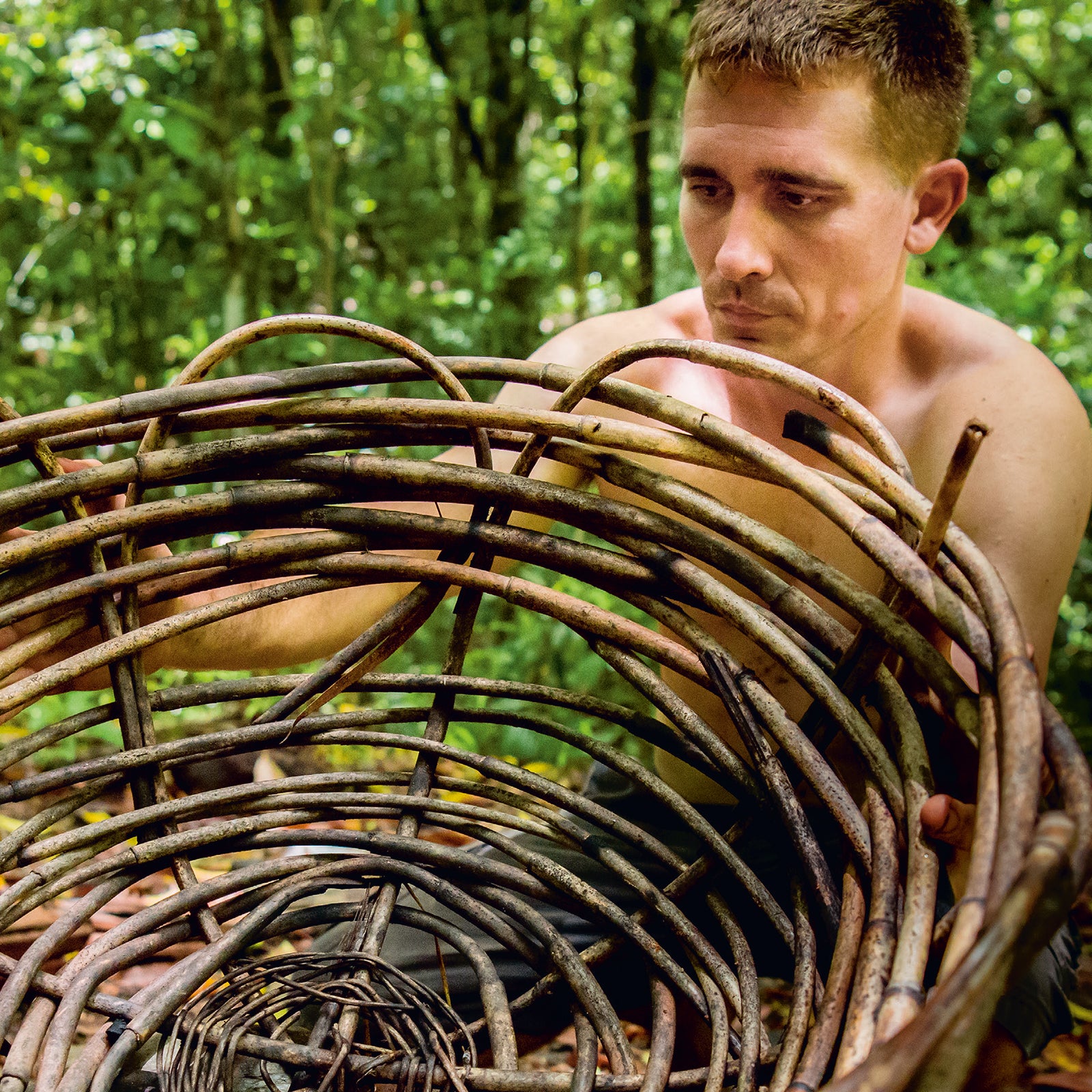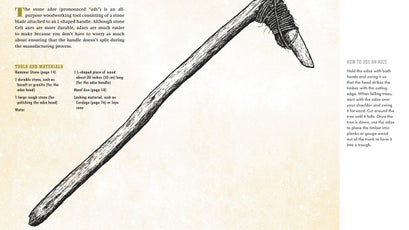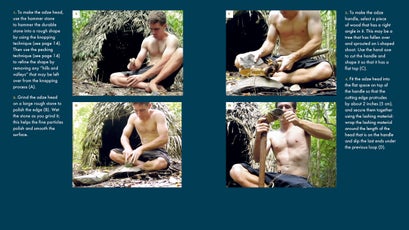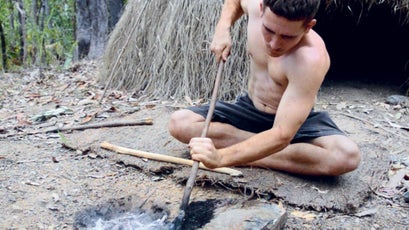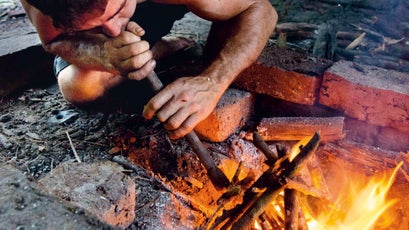John Plant might be the most popular YouTuber╠řwho has never spoken a word on camera. In the four years since the 36-year-old Australian started his channel, , heÔÇÖs attracted 9.8 million subscribers and racked up over 775 million views on his 48 videos. What does he do╠řto capture such a large audience? In each video, he goes out into the bush near his home in far north Queensland, with nothing but his now signature pair of blue shorts, and silently creates handmade╠řshelters and tools using only whatÔÇÖs available to him in nature. ThatÔÇÖs it. ÔÇťPrimitive technology is a hobby, where you go into the wild bare-handed and make things from scratch without using any modern tools or materials,ÔÇŁ Plant says. ÔÇťThat includes making the tools you need to make things. You can, in theory, with enough time, make anything that exists in modern times.ÔÇŁ
In the channelÔÇÖs , Plant builds a primitive wattle-and-daub hut, complete with a bed, fireplace, and chimney. But before viewers╠řsee╠řthe final structure, they watch Plant craft a stone hand ax╠řto chop wood, burn the wood to create a fire, gather material to fire clay pots, use the pots to carry water from a nearby stream, pour the water into dirt to make mud, and finally use the mud to insulate and support the walls of the╠řshelter. In other videos, he shows his audience╠řhow to , how to , and how to╠řmaster .
Plant graduated from James Cook University in Cairns, Australia, and then worked stints in soil testing, at a pottery shop, and at a powder-coating factory before leaving the nine-to-five╠řworld to mow lawns and spend more of his time in the bush. In 2015, he launched his YouTube channel and soon gained a large enough following that he could focus on building primitive dwellings full-time.
He was more surprised than anyone that so many people wanted to watch him painstakingly construct╠řthings in nature. But his videos give viewers a pause from modern life. Amid all the noise of social media, thereÔÇÖs a shirtless man in rural Australia spending his days scouring the forest for the perfect clay deposit or a proper tree for a thatched roof. And itÔÇÖs refreshing to watch someone work╠řin silence, without╠řnudging viewers╠řto subscribe to his channel or sneaking in mentions of corporate sponsors.╠řHis quiet demeanor╠řis a source of regular quips in the comments. ÔÇťI just realized the reason he doesnÔÇÖt speak is because he hasnÔÇÖt invented language yet,ÔÇŁ wrote one viewer╠řon a recent video titled simply╠řÔÇť.ÔÇŁ
After getting constant questions from viewers who wanted to╠řbuild from-scratch shelters in their own backyards, Plant decided to put all of his Stone Age knowledge into a guide. ($20, Clarkson Potter), out October 29, aims to be a wilderness resource for experienced craftsmen and newcomers╠řalike. It comprises╠řstep-by-step instructions on a variety of ancient practices, from starter projects╠řlike╠řdigging sticks and hand axes╠řto complex structures╠řlike updraft kilns and pyramidal huts. Ahead of the bookÔÇÖs release, we spoke with Plant about how he came to have╠řthis hobby, his wildly popular YouTube channel, and his next project in the woods.
On How He Got Started: ÔÇťI first got into primitive technology when I was 11. It wasnÔÇÖt strict bushcrafting╠řbut rather what kids do naturally. Back then╠řit was building paths, bases, hideouts, and traps with other kids my own age. What got me into this hobby is a lack of computer games and material possessions. My parents could afford expensive toys for me but didnÔÇÖt want to spoil meÔÇöbetter for children to be active anyway.ÔÇŁ
ÔÇťI used modern tools like machetes and ropes to make things. Then I suddenly decided that that was cheating and made a self-imposed rule of not using any modern tools or materials to make things in the bush. I can vaguely remember my first project,╠řat age 11,╠řwas a simple hut with a low rock wall and a dome roof made of sticks, covered with sheets of bark and leaves. ItÔÇÖs not still aroundÔÇöit was below the water level of the creek in the wet season. But it was fun to build this first hut. It was a small home away from home.ÔÇŁ
On Why He Started Sharing His Work Online: ÔÇťI made videos to show friends and family, and they started saying I should put it on YouTube. The first video (ÔÇťÔÇŁ) shows the progression of a hut over nine months, with many components to it. I just kept editing new things into it to show people I met. Before that I only took photos of my projects for my own interest.ÔÇŁ
On His Reading List: ÔÇťWhen taking on a project, you must research it thoroughlyÔÇöhow much material was used, dimensions, weights, etc. Then you try to create the thing, see how it goes, and then try something else if it doesnÔÇÖt work. Trial and error plays a big part after the research phase is done. IÔÇÖve read╠řthe , by John Wiseman,╠řfor shelters and bow making and ,╠řby J.E. Rehder, for furnaces and pyrotechnology. But mainly internet research.ÔÇŁ
On the Most Difficult Skills to Learn: ÔÇťFire making and metallurgy. In learning fire making with the hand drillÔÇöspinning a stick in the socket of another stickÔÇömany blisters were had. I was 18 by the time I got my first fire. It would have been earlier if I had a teacher to learn from or todayÔÇÖs internet╠řat least. With smelting iron, I had to learn many different skills and made up some by myself.ÔÇŁ
On Staying the Night in One of His Shelters: ÔÇťIÔÇÖve stayed in╠ř. It had underfloor heating, which I tested at night in winter. I put palm fronds on the sleeping platform, and it stayed warm all night. It rained a bit, but the roof kept the rain off, and I had a fire and bed made from wood and moss, quite comfortable. I ate yams and sweet potatoes from the garden in front of the hut. It lasted three years before termites ate the wooden roof and the tiles came down. The walls dissolved in the rain after that.ÔÇŁ
On How Popular His Channel Became: ÔÇťI was surprised when my videos started to pick up in popularity, to be honest. There was already a well-established bushcrafting community on YouTube, and I didnÔÇÖt think IÔÇÖd be anywhere near as popular as the outdoor and camping channels that used modern tools and materials. I thought that, at best, there would be a niche audience who was interested in making things completely from scratch in the wild. I think╠řthereÔÇÖs a lesson here for people reading this: if you have an unusual hobby that youÔÇÖre interested in, but think others may not be, then put it out there for a larger audience to see. Chances are, if youÔÇÖre interested in it, there will be at least a few thousand people in the world who are also.ÔÇŁ
On Being Silent in His Videos: ÔÇťThat was originally by laziness rather than by design. I showed my first video to two different friends initially, and both said the video needed narration or no one would watch it. I had edited the video already and couldnÔÇÖt be bothered to narrate it. Though some people complained about the lack of narration, most preferred it to other channels that talked excessively. To compromise, I added subtitles that people could turn on in their YouTube settings for more in-depth, real-time explanation.ÔÇŁ
On How Engrossing the Work Is: ÔÇťWhen IÔÇÖm immersed in a task, I donÔÇÖt think about anything else outside of it. ThatÔÇÖs a good way to be. Sometimes I wonder what ancient people did, and how my work would compare to theirs, and what theyÔÇÖd think if they saw the way I do things. Most things theyÔÇÖd think I did╠řworse for sure, but some things better also.ÔÇŁ


